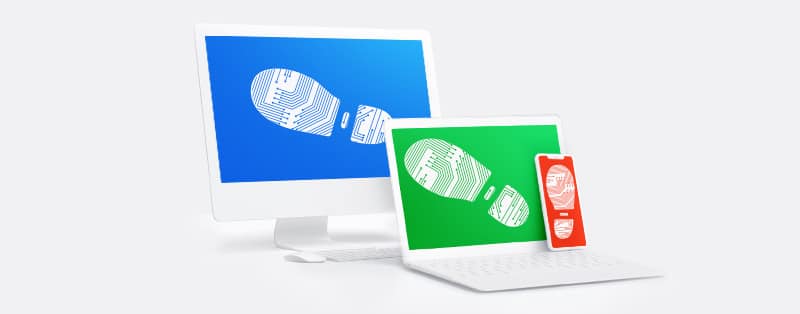What Is a Digital Footprint?

The internet is a vast space with seemingly endless information. Many people turn to the internet for many activities like emailing, data transfer, gaming, streaming, and banking services. Unfortunately, as much data as the internet provides, it also collects.
Your every activity online leaves a trail that leads back to you. This trail you leave behind is what we call ‘digital footprints’. You leave these breadcrumbs knowingly or unknowingly as you surf the internet, filling forms or downloading videos.
These footprints serve different purposes, could be good or bad. For example, companies use digital footprints to target ads at you, but other malicious parties could track and attack you. So, what exactly are digital footprints? How do you leave them, and how can you reduce the tracks you leave behind? This article will highlight all there is to know about digital footprints.
What Is a Digital Footprint?
A digital footprint is the trail of electronic data you leave as you use digital technology. You leave these footprints behind when you surf the internet, interact on social media, use smart TVs, download or upload files, and other activities. The internet is like a wide wet beach, and with each step you leave a footprint. However, while you’re sure that a wave will wash your prints away or they fade off in a physical beach, it is a lot different with the internet.
Most signs or footprints of your activities online exist permanently on the internet unless you intentionally try to erase them. The information you share about yourself online can be used to monitor your online behavior and habits, or it can be used to study your personality.
Your safety online often depends on who has access to your information and what is done with it. It’s hard to control the flow of your data once you make it available on the internet. There are two types of digital footprints you can leave:
Active Digital Footprints
Active digital footprints refer to all the information you intentionally submit to or collect from websites and other online services. Sharing a photo online, filling a form, or sending an email are examples of active digital footprints since you already expect other people to see or save the data. The more posts you share, the longer the trail of your digital footprints grows.
Passive Digital Footprints
A passive digital footprint is a trace of data you leave or collect without you being aware. When you choose movies to watch on a streaming platform, you leave clues that tell the provider your movie preferences to create a section for similar movies you may like.
Also, websites may pick up your IP address the moment you visit, and they inadvertently can tell who your Internet Service Provider (ISP) is and your possible location. Your search history is one way you may unknowingly leave passive digital footprints about personal aspects of your life.
However, technology has continued to develop, and our lives are more connected to the digital space than before. Everyone on the internet leaves a digital footprint, so it’s not something that can be completely avoided. Nonetheless, it is important to understand the various ways you leave digital footprints and how you can avoid leaving too much information online.
Ways You Leave Digital Footprints
There are tons of stuff you do online that leave digital footprints. Some of the most common ways include:
Cookies
Most websites, news, streaming, and shopping platforms use cookies. Cookies are used for logging your activities and keeping track of your traffic across other websites. The information collected by cookies helps advertisers know your preferences.
Have you ever noticed how shopping or streaming platforms suggest things related to your search history, recent purchases, or movie choices? It’s your digital footprint that’s giving them ideas. Accepting cookies from suspicious websites can help hackers design specific attacks for you.
Social Media
Social media platforms are places most of us spend our time, which means we leave more digital footprints on those platforms than other areas of the internet. Every tweet, retweet, comment, likes, and video you watch leave your footprints behind.
Your digital footprints on social media are useful for admins to suggest people you should follow or send friend requests. This data trail also includes your personal information, which you put up online. So, you need to be careful of what you post or share.
Mobile Phones and Other Devices
There are several websites out there that don’t just track your browsing activities. They can also tell what device you’re connected with. Websites use such information to monitor your account for security reasons, but it can also be used to study your online habits.
For example, when you connect to your Netflix account on a Smart TV, the platform will be able to identify details about the TV you’re using. Similarly, on Twitter, the platform identifies the device you send tweets from.
How Can You Manage Your Digital Footprints?
As we said, information that makes it to the internet may probably stay there permanently. Even if certain content is intended for a select audience, there’s no way to guarantee that it won’t be shared further, so it is advisable to be mindful about what we share. However, some effective ways allow you to control your digital footprints. They include:
Delete Your Old or Unused Accounts
It is very important that you don’t leave unnecessary digital footprints. Millions of users worldwide sign up for different online shopping, e-mail, and social media accounts. We’re all guilty of uploading personal information and other details on platforms that we sometimes forget.
If you have old accounts or those you no longer use, you need to get rid of them as soon as you can. This limits the information about you that is available online. If hackers get access to an old account that you’ve used for business or other financial activities, it would be a lot easier for them to do some damage. And since you’ve not paid attention to such accounts for a while, you may not notice early on that your security has been breached.
Filter Your Email Subscriptions
Email newsletters and offers are regular guests in our boxes, and we often pay very little or no attention to them even though they pile up. Having so many emails is one aspect of the problem. It shows that you have used your email to subscribe to various services and possibly shared some personal information with all those service providers. Unless you’ve verified by reading their privacy policy, they might share your data with third parties.
If you’d like to limit your footprint, you will have to unsubscribe from all the lists you are not actively using and only receive emails from those you’re interested in.
Adjust Your Privacy Settings
Privacy settings are easy to tweak, but they play an important role in the way you leave a digital footprint. They let you control the privacy of the content you publish online. On social media platforms, for example, you can control the visibility of your post to other users.
If you don’t have strong or convenient privacy settings, your data is public information. Some people ignore the privacy settings of online platforms and services, and it leads to different cases of cybercrime such as identity theft and data loss.
Check The Information About You That Is Online
Social media platforms you use, forums, your several online accounts, and other activities online create several links to you. Digital footprints can help you create the kind of online persona you want. However, with all the activities we engage in regularly, there may be so many aspects about us that get portrayed differently than we’d like.
A simple way to know the information the internet has on you is to search for names online through search engines. The top three searches usually have more details about you. This gives you a clue of how much personal information is on the internet, and if you don’t want to have something specific online, you can take it down yourself or contact the publisher.
Don’t Always Link Your Accounts
These days, there are easy ways to sign up or log in online that require linking social media accounts like Facebook or Google. You should always check the level of access you are giving to those third-party sites or services before you link your accounts because it affects your digital trail.
Use a Virtual Private Network
A Virtual Private Network, or VPN, is an effective technology that can hide your real IP address, encrypt your data, and help you access the geo-restricted content on streaming platforms. A VPN’s ability to cloak your IP and encrypt your traffic makes it a great way to control your digital footprint.
A VPN gives you a new IP address from the virtual server you connect to. So, even if websites can see that you’re visiting, they can’t know your real identity. This is useful if you use public Wi-Fi networks regularly or if your Internet Service Provider (ISP) or government agencies actively track your online activities.
Disable Location Tracking
When you have location tracking enabled on your devices, most content you see online is based on your location. This is useful if you want to see only contents that relate to your region. However, this allows service providers to track your movements also. If you don’t want to use a VPN, you can disable location services on your devices.
Just go through the system settings on your devices till you come across the option. On iPhone, go to your Settings > Privacy > Location Services and disable Location Services. For Android, go to Settings > Security & Location > Location and toggle off the Use Location feature.
Conclusion
Whether you like it or not, you leave a digital footprint when you use the internet. As you’ve read, there are different ways you leave a digital trail. However, you can control how much of your information is shared online. We’ve pointed out a couple of methods you could use to limit your digital footprint and protect your privacy.
